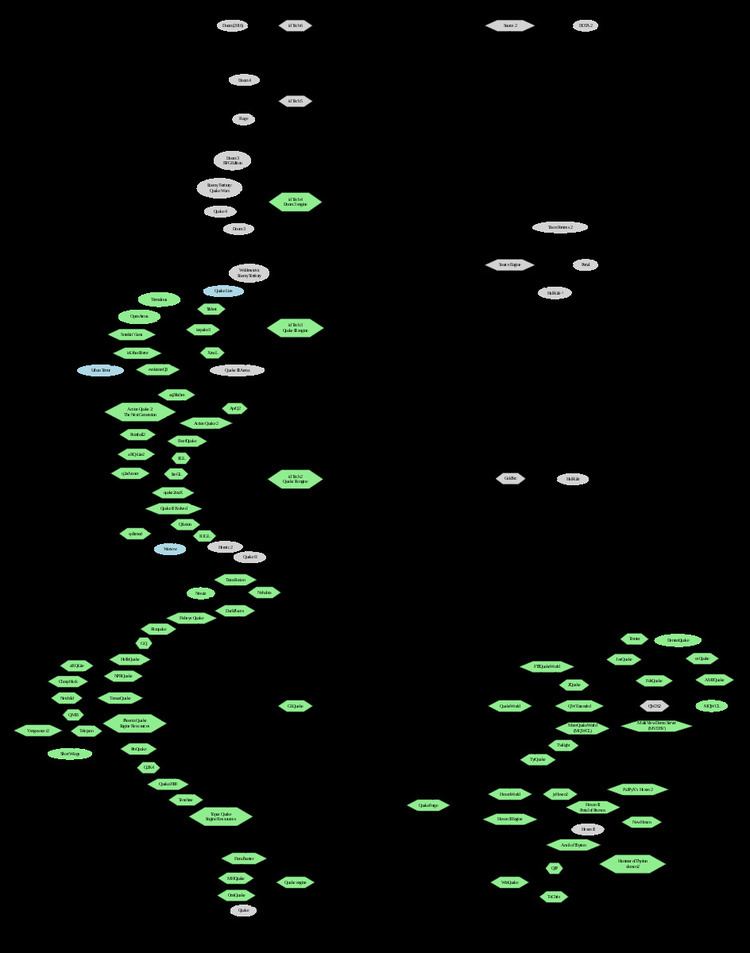 | ||
id Tech is a series of separate game engines designed and developed by id Software. Prior to the presentation of the id Tech 5-based game Rage, the engines lacked official designation and as such were simply referred to as the Doom and Quake engines, from the name of the main game series the engines have been developed for. "id Tech" numbers 2, 3, and 4 have been released as free software under the GNU General Public License, along with the source code to Wolfenstein 3D, Doom, and Quake.
Contents
According to Eurogamer.net, "id Software has been synonymous with PC game engines since the concept of a detached game engine was first popularised." However id Tech 4 had far fewer licensees than the Unreal Engine from Epic Games, and id planned to regain the momentum with id Tech 5, until they were bought by ZeniMax Media which intends to keep the id Tech engines exclusively for id's sister studios.
Predecessors
id Software had developed 3D engines for several games before Doom. Each game's engine had progressively more advanced 3D technology.
id Tech 1
Originally known as the "Doom engine", this engine powers the id Software games Doom (1993) and Doom II: Hell on Earth (1994). It was created by John Carmack, with auxiliary functions written by Mike Abrash, John Romero, Dave Taylor, and Paul Radek. Initially developed on NeXT computers, it was ported to MS-DOS for Doom's release and was later ported to several game consoles and operating systems.
The code was also reused for other titles, such as Heretic and Hexen: Beyond Heretic (both by Raven Software), and Strife: Quest for the Sigil (Rogue Entertainment).
id Tech 2
Previously known as "Quake engine" with its successor "Quake II engine", it was originally written to power 1996's Quake. It featured true 3D real-time rendering and is the first id Tech engine to use the client–server model.
The Quake engine was updated with a new executable titled QuakeWorld that contained code to enhance the networking capabilities of Quake in response to the demand for across-internet network games that arose as a result of Quake's usage of UDP for networking.
It was later updated again for the release of Quake II in 1997, with enhancements such as colored lighting and a new MD2 model format.
id Tech 3
Previously known as the "Quake III Arena engine", it is used to power id Software's Quake III Arena in 1999.
The Quake III Arena engine was updated to patch 1.26 and later versions are called "Quake III Team Arena engine" with a new MD4 skeletal model format and huge outdoor areas. It was updated again with the 2001 release of Return To Castle Wolfenstein which included a single-player scripting system, and was eventually used to power the first Call of Duty title in 2003.
id Tech 4
Commonly known as the "Doom 3 engine" which was used to power Doom 3 as it released in 2004, id Tech 4 began as an enhancement to id Tech 3. During development, it was initially just a complete rewrite of the engine's renderer, while still retaining other subsystems, such as file access, and memory management. The decision to switch from C to the C++ programming language necessitated a restructuring and rewrite of the rest of the engine; today, while id Tech 4 contains code from id Tech 3, much of it has been rewritten.
Other games using this engine were Raven Software's Quake 4 (2005) and Wolfenstein (2009), Human Head Studios' Prey (2006), Splash Damage's Enemy Territory: Quake Wars (2007) and Brink (2011).
id Tech 5
Used for id Software's Rage, the engine is based on the file system frameworks. Some technologies included are the GUI system from id Tech 4, including a new renderer, MegaTexture 2.0 technology, soft shadows and more. id is requiring companies that use the engine to publish their games through id's sister company, Bethesda Softworks.
The engine has since been used to power both of MachineGames' Wolfenstein titles; The New Order in 2014 with its standalone expansion The Old Blood, which released in 2015. It was also used for Tango Gameworks' The Evil Within (2014).
id Tech 6
The latest game engine by id Software, was used for the Doom reboot released on May 13, 2016 with cross-platform support for online play between Microsoft Windows, Xbox One, and PlayStation 4. While the engine uses some of the features from id Tech 5, id has also added support for Vulkan rendering. Development of the renderer is led by Tiago Sousa, who had previously worked on CryEngine, following previous technical director John Carmack's resignation in 2013.
